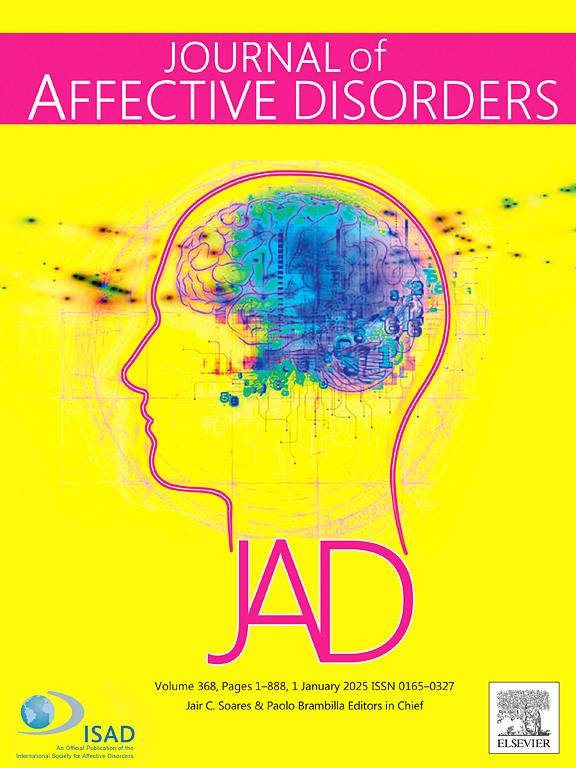受虐待与未受虐待青少年抑郁和焦虑症状网络的比较
IF 4.9
2区 医学
Q1 CLINICAL NEUROLOGY
引用次数: 0
摘要
背景虐待是抑郁和焦虑症状的一个公认的危险因素。然而,在有虐待史和没有虐待史的青少年中,这些心理健康问题在症状水平上的关联仍未得到充分探讨。本研究采用网络分析比较两组的抑郁和焦虑症状网络。方法对6618名中国青少年进行横断面研究。采用《儿童创伤简易问卷》评估虐待行为,采用《患者健康问卷》和《广泛性焦虑障碍量表》分别测量抑郁和焦虑症状。网络分析分别对有虐待和没有虐待的青少年进行,并使用网络比较测试进行比较。结果纳入的青少年(平均年龄[标准差]:14.5[1.6]岁;52.2%男孩),63.8%报告遭受虐待。受虐待的青少年比未受虐待的同龄人抑郁和焦虑症状更严重。网络分析发现,两组患者的主要症状为“无法控制的担忧”、“过度担忧”和“难以放松”。在虐待组中,“易怒”是关键的桥梁症状,而在非虐待组中,“紧张”是关键的桥梁症状。与非虐待组相比,虐待组表现出更强的网络连接和显著不同的网络结构。“自杀意念”在虐待组有更高的预期影响和三个更强的边缘。结论两组均存在重叠且明显的中心症状和桥状症状,虐待组尤其需要注意“自杀意念”。这些发现强调了干预措施的重要性,即解决青少年共有的症状模式,同时为有虐待经历的青少年纳入量身定制的组成部分。本文章由计算机程序翻译,如有差异,请以英文原文为准。
Comparison of depressive and anxiety symptom networks in maltreated and non-maltreated adolescents
Background
Maltreatment is a well-established risk factor for both depressive and anxiety symptoms. However, the symptom-level associations between these mental health issues in adolescents with and without a history of maltreatment remain underexplored. This study employed network analysis to compare depressive and anxiety symptom networks across these two groups.
Methods
This cross-sectional study involved 6618 Chinese adolescents. The Childhood Trauma Questionnaire-Short Form was used to assess maltreatment, while the 9-item Patient Health Questionnaire and the 7-item Generalized Anxiety Disorder scale were used to measure depressive and anxiety symptoms, respectively. Network analyses were conducted separately for adolescents with and without maltreatment, and compared using network comparison tests.
Results
Of the adolescents included (mean age [standard deviation]: 14.5 [1.6] years; 52.2 % boys), 63.8 % reported experiencing maltreatment. Maltreated adolescents had more severe depressive and anxiety symptoms than their non-maltreated peers. Network analysis identified “Uncontrollable worry”, “Excessive worry”, and “Trouble relaxing” as central symptoms in both groups. “Irritability” emerged as the key bridge symptom in the maltreatment group, whereas it was “Nervousness” in non-maltreatment group. The maltreatment group exhibited stronger network connections and significantly different network structure compared to the non-maltreatment group. “Suicidal ideation” had higher expected influence and three stronger edges in the maltreatment group.
Conclusion
Both overlapping and distinct central and bridge symptoms were identified across the two groups, with “Suicidal ideation” requiring particular attention in the maltreatment group. These findings highlight the importance of interventions that address shared symptom patterns across adolescents, while incorporating tailored components for those with maltreatment experiences.
求助全文
通过发布文献求助,成功后即可免费获取论文全文。
去求助
来源期刊

Journal of affective disorders
医学-精神病学
CiteScore
10.90
自引率
6.10%
发文量
1319
审稿时长
9.3 weeks
期刊介绍:
The Journal of Affective Disorders publishes papers concerned with affective disorders in the widest sense: depression, mania, mood spectrum, emotions and personality, anxiety and stress. It is interdisciplinary and aims to bring together different approaches for a diverse readership. Top quality papers will be accepted dealing with any aspect of affective disorders, including neuroimaging, cognitive neurosciences, genetics, molecular biology, experimental and clinical neurosciences, pharmacology, neuroimmunoendocrinology, intervention and treatment trials.
 求助内容:
求助内容: 应助结果提醒方式:
应助结果提醒方式:


